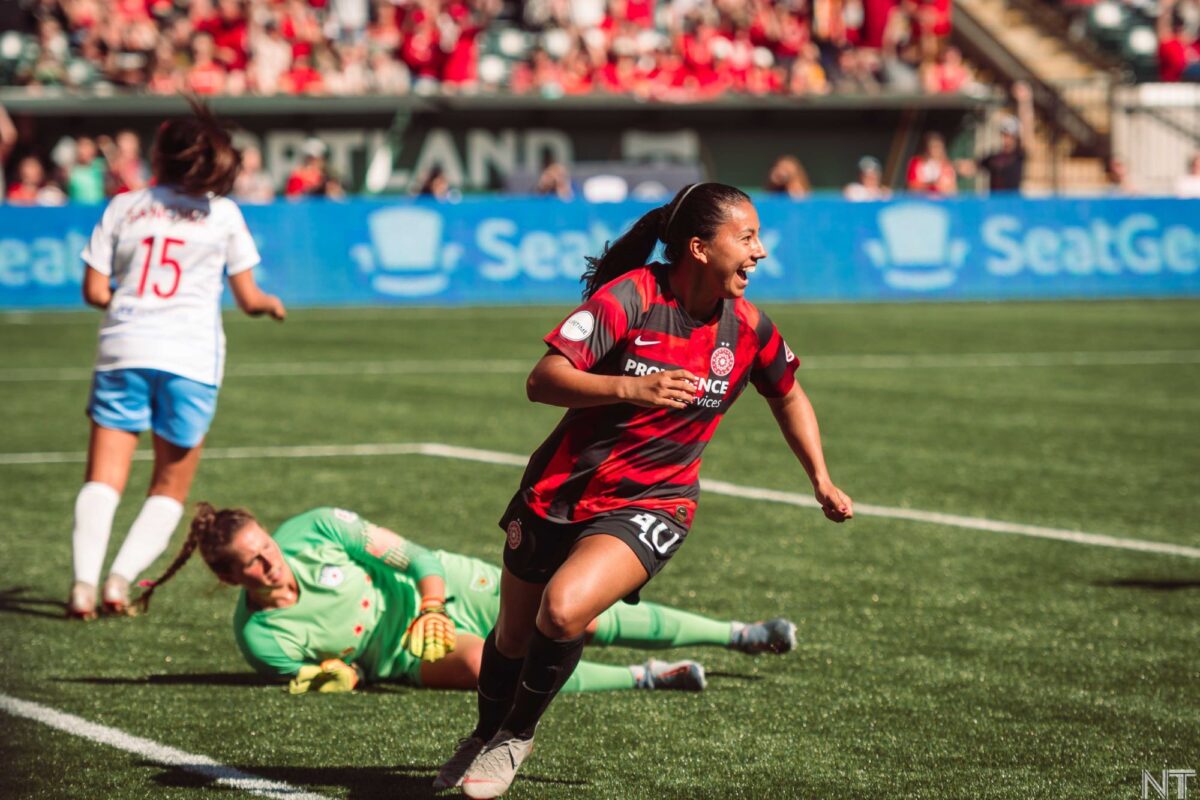To view this content, you must be a member of the Rose City Review Patreon
Already a qualifying Patreon member? Refresh to access this content.
Leo Baudhuin is a student journalist covering the Thorns and the NWSL. They love cats, climbing, and Gritty, and they’re always down to talk about astrology. (They’re a gemini, if you were wondering.)
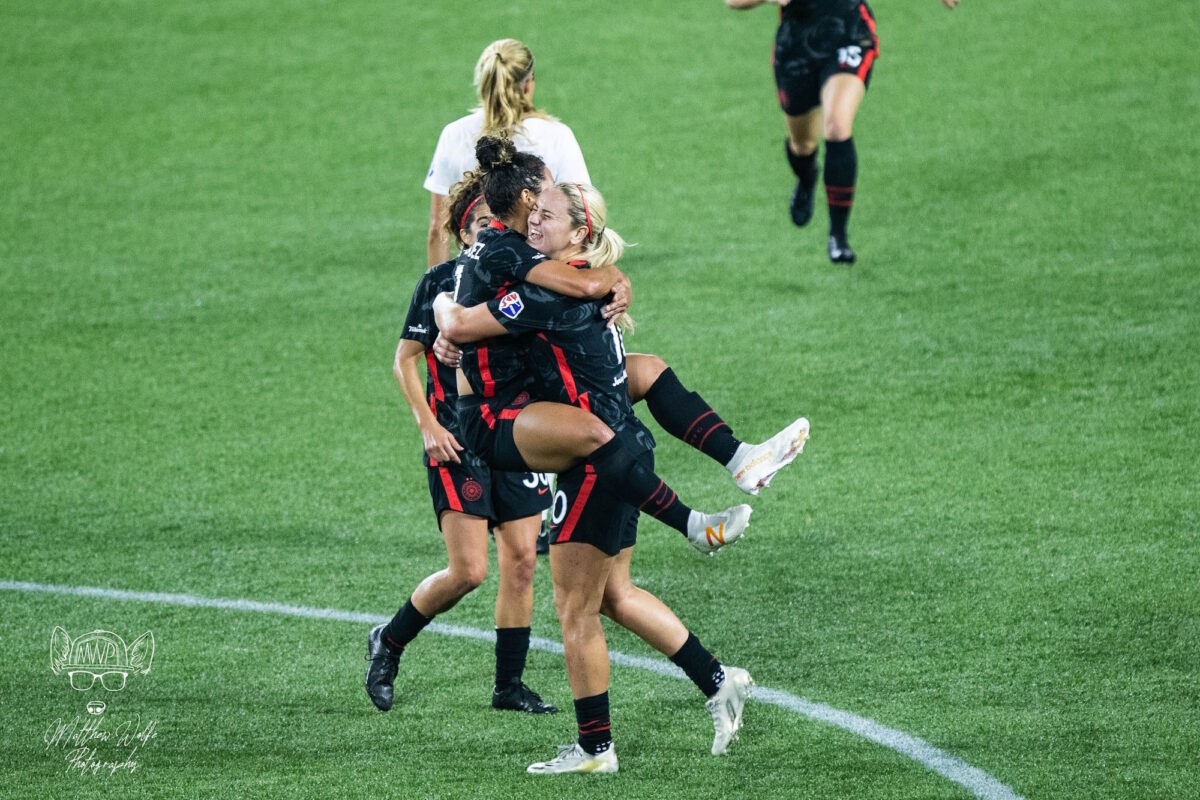

Unless you’ve had your head under a rock for the last six hours, you’ve likely heard the news: Crystal Dunn is a Thorn.
It’s not poppycock this time—thanks to OL Reign taking one for the team(s) and “facilitating” the trade. The 2019 World Cup Champion, two-time NWSL Champion, NWSL golden boot winner and MVP of the 2015 season’s move to Portland (finally) extends beyond the offseason.
In exchange, the Thorns sent the Reign $150,000, a 2021 international slot, and Portland’s natural first-round pick in the 2022 college draft. Here are a few of our takeaways about the big news:
With multiple expansion drafts on the horizon and no clear answer to whether soccer in the traditional sense will even be possible in 2021, the Thorns’ future—like that of many teams in this league—is uncertain (more on that in a minute). What looks pretty watertight at this juncture is that Portland’s midfield is going to involve all of Lindsey Horan, Crystal Dunn, and Christine Sinclair.
Those players aren’t going anywhere, which is, uh, crazy? It feels like cheating. Then again, when Dunn went to North Carolina, that also felt like cheating—so maybe what it boils down to is that having Crystal Dunn is cheating.
Dunn is one of the few players in the world who can genuinely bend a game to her will. She can score practically at will and is equally dangerous at both dribbling and passing. She’s a defensive threat, too. It’s hard to overstate how huge an acquisition she is for the Thorns, especially when you start to think about her connecting with oh, say, Sophia Smith.
This looks like a superteam for now, but not so fast. Three expansion drafts are looming in the next two years, with one—for Racing Louisville—happening in less than a month. Don’t expect this to be the last move Portland makes this offseason.
Assuming the rules are the same as they were in 2015, the Thorns will be able to protect nine players, including two USWNT-subsidized players. As things stand, the two protected subsidized players have to be Dunn and Horan. We’d already expected them to lose at least one keeper, likely AD Franch, but now she, Heath, and Sauerbrunn will all be on the chopping block. (Sophia Smith is blissfully saved by the fact that USWNT allocations won’t be announced until after the expansion draft.) Sauerbrunn probably doesn’t get taken—she’s 35 and has made it clear she wants to settle down in Portland. We think she tells any interested team she’ll retire rather than report.
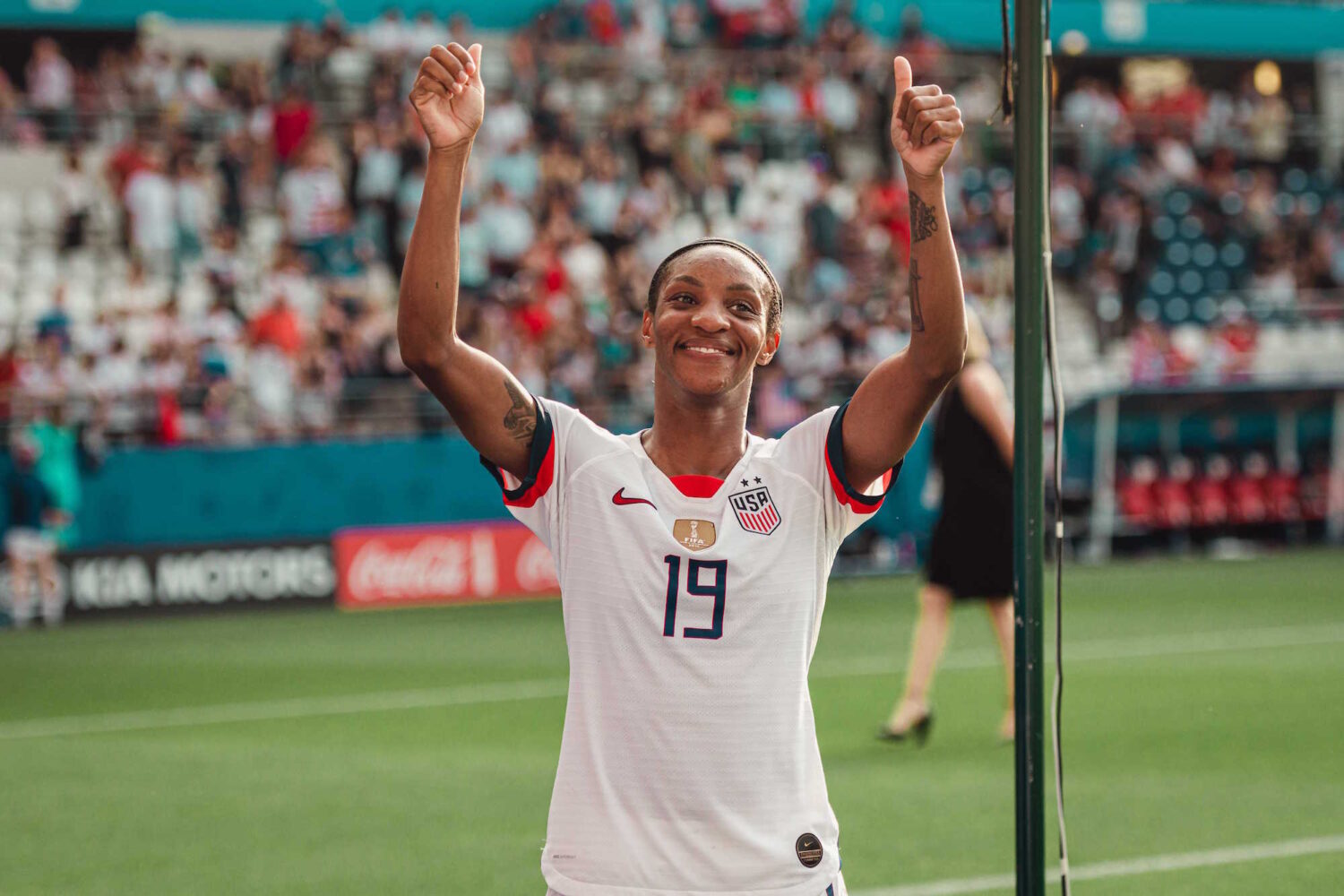
Heath? Harder to say. She also owns a home here and clearly likes playing for the Thorns. She also holds the same leverage as any elite player in this league: she can always decide to extend her time in Manchester rather than move to Louisville or Sacramento. However: it’s not hard to imagine, say, Louisville picking up her rights, her deciding to stay in England for 2021, and then forcing a trade to LA for 2022.
Of course, that’s assuming the Thorns can scam them into taking the rights of someone who probably doesn’t plan on playing for them, but the Thorns have a pretty solid track record when it comes to taking advantage of other teams (see: The Alex Morgan Trade). That’s also assuming Angel City wants Heath on their side, but it’s hard to imagine a team saying no to her if she asks.
We’ve all been dreading/denying the inevitable: that one day, sure as the cruel sea beats cliffs into sand, Christine Sinclair will have to retire. That she’s had an almost unbelievably long and consistent career doesn’t change how problematic this is for the Thorns in the long term.
A situation that we think epitomizes this pretty well was last year, when the Thorns tried three different players at the No. 10 while Sinclair was away for the World Cup. Dagný Brynjarsdóttir, Ana Crnogorčević, and Andressinha—may she be free forevermore—are all good players, but the team’s reliance on an all-time great in that position showed in her absence.
Dunn is the answer to that, positionally at least. As far as Sinclair’s importance to the locker room, there’s of course no real replacement, but Mark Parsons seems to think Dunn has some of the same qualities as a leader, too. “She has such a contagious energy about her that just wants to make you be better when you’re around her,” he said in an interview released by the team today. “But what she doesn’t get praise enough for is her leadership, and the way that she leads. By example, and by being positive, and by being driven. She’s had a lot of success, and it’s not by luck.”

So, there have been four soccer games, and the Thorns won three quarters of them, which puts them ahead of the Houston Dash to win the Verizon Community Shield in the NWSL Fall Series.
That doesn’t mean a third star—it wasn’t a real season, after all—but it sounds like Portland has other ideas. “We were joking maybe we could get a little ghost, or maybe a mask to put on our jerseys,” Christine Sinclair said tonight, “but we’ll figure that out in the offseason.”
Even with the notable lack of a star, the winners of the Shield aren’t leaving Cheney Stadium empty-handed. The 2–1 victory secured them the first place prize for the fall season: a $25,000 grant to a local business. For the Thorns, that’s Mimi’s Fresh Tees, a “woman owned social justice t-shirt company,” according to the company’s Instagram.
The Thorns wore Mimi’s Tees to their home game on September 30—what would turn into a 4–1 win over OL Reign.
http://www.instagram.com/p/CFyBDs-jXrA/
“It’s great to have something to play for,” said Becky Sauerbrunn after tonight’s match. “As a team we’ve really dug deep into, okay, how can we help, especially our community […] To be able to give an independent business in Portland this amount of money, we’re really proud, and we’re really happy that we get to contribute to the community.”
While that’s wonderful to see, I have to say I’m not sure I took all that much from the game from a soccer perspective. OL Reign came out of the gate strong, with the likes of Bethany Balcer and Jasmyne Spencer putting Portland’s defense under a decent amount of pressure. As Sauerbrunn pointed out, though, the Thorns did a fantastic job of defending as a team and were able to both weather the storm and steal a penalty kick goal to give them the lead before halftime.
Tacoma lost their edge after the first half hour of the match, although they did sneak one past the Thorns’ defense off a 46th-minute free kick. And then there was another buried penalty that allowed Portland to regain their lead.
But besides the goals and the Thorns absorbing that initial run of Reign offense, I can’t say it was a particularly fun match. Tacoma decided to play a tightly-marked game and tackle hard when Portland had the ball, and the Thorns, for their part, weren’t able to play out of that pressure for longer than a few passes.
Yeah, maybe Portland being a little sharper on the attack could’ve earned them a few points—they looked marginally better than they did on three day’s rest at Utah last weekend. And maybe they would have beat Casey Murphy, who was playing incredibly high off her line, if that had been the case. But they didn’t, and the match was a tricky one as a result, with the exception of a few plays.
The thing about Amber Brooks is that silly—some might say bad—defending isn’t anything new for her. Nine times out of ten, though, that manifests itself in getting caught too far up the field (something that isn’t super ideal for a center back), or ball-watching as her mark makes a relatively unimpeded run to the goal.
Rarely does it mean that she’s involved in all three of a game’s goals, fouling two different Thorns in the box to create Portland’s penalties and directing a weirdly-deflected ball on frame for OL Reign’s lone goal of the night.
Obviously I want to contextualize it with the fact that three of them were penalties, but Christine Sinclair scored six goals in the last three games at the age of 37, and I feel like we should talk about that.
She’s also very clearly living her best life right now, which she deserves:
The visiting locker room in Tacoma seems like the place to be tonight. 🥂 #BAONPDX pic.twitter.com/oQjjNcoKiP
— Portland Thorns FC (@ThornsFC) October 11, 2020
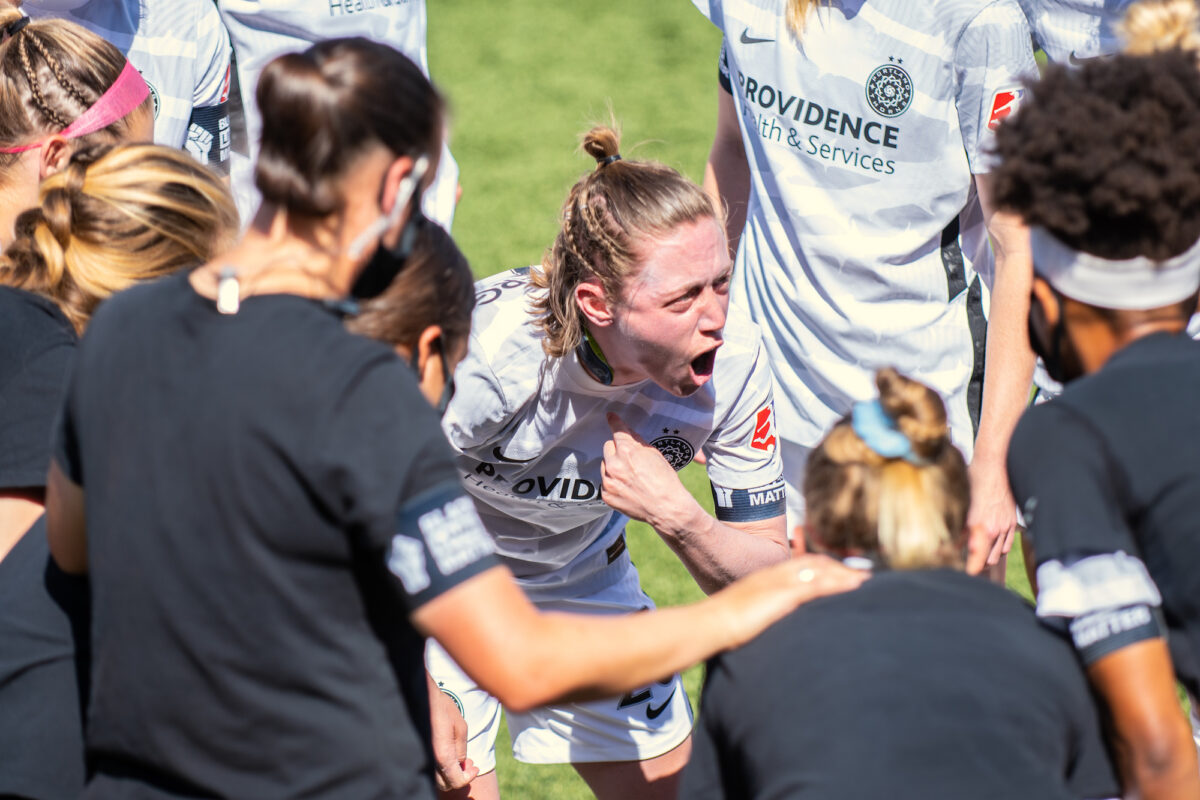
After wrapping up the preliminary round of the Challenge Cup winless in last place, the Portland Thorns pulled out a thrilling 1–0 win over the North Carolina Courage with a 68th-minute goal from rookie Morgan Weaver.
The match marks the first playoff game that the Courage have lost since the 2017 NWSL Final, and the first time North Carolina has been shut out since last May.
Beyond the tournament-ending injuries for AD Franch, Becky Sauerbrunn, and Sophia Smith, Bella Bixby, Lindsey Horan, and Emily Menges were also listed as questionable ahead of today’s match. While both Horan and Menges started the game, Bixby’s right knee injury paved the way for Britt Eckerstrom’s first start since August of last year.
Unfortunately, the knocks didn’t end there. The first half of the match saw both Horan and Katherine Reynolds go down—for Reynolds, in a head collision with Lynn Williams that saw both of them bleeding and Reynolds subbed off the pitch.
Horan was able to come out in the second half, but fell to the ground again in Portland’s defensive box. She was subbed out for Celeste Boureille in the 51st minute.
Especially given the fact that the Thorns have looked uninspired without Horan in this tournament, these early injuries were worrying.
Portland started the game with Reynolds on the right, Meghan Klingenberg on the left, and an Emily Menges-Kelli Hubly centerback pairing. In her 40 minutes on the field, Reynolds was often left dealing with Williams up North Carolina’s left flank, and found herself burned by Williams a handful of times—including in the first minute of the match.
While Reynolds is a better defender when isolated one on one, the decision to start her over the faster Christen Westphal was questionable, and the Thorns were lucky that the Courage didn’t take advantage by overloading that side with Williams and Jaelene Daniels.
The other somewhat illogical choice, in the first 20 minutes at least, was the partnership between Menges and Hubly. At the beginning of the match, Menges was consistently the player stepping higher to win the ball while Hubly hung back, something that felt counterproductive given their respective strengths. However, the duo figured things out as the match went on, with Hubly more often pushing up to win the ball and Menges stepping to take on players.
After scoring a total of two goals in the preliminary rounds—with one of those goals coming off a Horan set-piece header—things didn’t look particularly promising for Portland’s attack heading into this one. On top of that, they’ve looked significantly worse without Horan.
Regardless, the Thorns broke through when Christen Westphal played a pass up the line Rocky Rodríguez. Rodríguez dribbled to the endline and squared her hips to send a low cross front of goal and beat her defender. Morgan Weaver peeled off Addisyn Merrick at the far post to tap the ball in, and the Thorns were up with their first game-winner of the tournament.
Go on and shine, Rook ✨
Morgan Weaver gives @ThornsFC the lead!
0-1 | #NCvPOR
Tune in now on @CBSAllAccess and @Twitch.#NWSLChallengeCup pic.twitter.com/pFSBk0XrKk
— National Women’s Soccer League (@NWSL) July 17, 2020
Slipping down Portland’s goalkeeper depth chart to the third string, it was hard to know what to expect from Eckerstrom going into this game. Fortunately, she did really, really well.
If she had any nerves, Eckerstrom worked through them in the first half; her handling was a bit shaky, and she was lucky to catch her own rebound on two separate occasions. She was also fortunate in the fact that North Carolina struggled to put their shots on target, with a handful of sitters hit wide of goal or missed completely.
However, the Thorns ended the half 0–0, and Eckerstrom showed flashes of the fantastic positioning and ability off her line that she relied on heavily in the second part of the game.
And that second half was something to behold; Eckerstrom was everywhere across the face of goal. She came out several times to smother a through-ball in traffic—including blocking a Courage breakaway and deflecting the rebound wide—and got a strong punch to a brilliant Debinha free kick to preserve the Thorns’ lead.
.@Breck28 take a bow 🙌
An absolute incredible save by the @ThornsFC goalkeeper for the @Verizon Save of the Match.#NWSLChallengeCup pic.twitter.com/8lyM7tG9HF
— National Women’s Soccer League (@NWSL) July 17, 2020
Eckerstrom was absolutely fantastic today, but it was kind of cool to see Nadine Angerer listed as a sub for the Thorns—even if it was the result of Portland’s first- and second-string keepers being injured. And, yeah, it was a great game, but can you honestly say it wouldn’t have been better if Angerer had gotten a couple minutes at the end?

Was a non-roster invitee for the Thorns ahead of 2017. Never appeared for Portland, but ended up playing ten games in Norway that same year. According to Soccerway, is now affiliated with a second-tier club in Sweden (joined by a teammate of the name Emilie Brandt).
Stuck around for two seasons as Portland’s third-string keeper in the pre-Bella Bixby days. Was called up as an amateur player for a bit in 2016—presenting us with the never-realized possibility of having an Emily in goal behind an Emily center back pairing—but didn’t get to take the field for the Thorns. Allegedly went to Cal, claimed the number 19 jersey in Portland, and is a Scorpio, but otherwise her identity is something of a mystery.
The Thorns’ longest-tenured center back. Drafted out of Georgetown in the third round in 2014, making her arguably the best value ever to emerge from the NWSL College Draft. Had a legendary block against Jess McDonald late in the 2017 championship. Coined the phrase “let’s make a constellation.”
The wildest ball of lightning to ever pull on a Thorns jersey. The number one overall pick in the 2016 draft. Incredible one moment, inexplicable the next, and an absolute content machine, on and off the field. The inaugural NWSL Most Online Player; hexed by Amy Rodriguez late in the 2019 season.
Made four appearances for the Thorns in 2013 after starting as a trialist. A 2004 Stanford graduate who stepped away from the game before joining the Bay Area Breeze of the now-defunct USL W-League. The rest is lost to history.
The legendary poet out of Mount Holyoke Female Seminary. Refused to play if the Thorns weren’t in their white kits. After a playoff loss in the 1861 season, she was asked a generic question about the emotions in the locker room, and replied:
Success is counted sweetest
By those who ne’er succeed.
To comprehend a nectar
Requires sorest need.
Not one of all the purple Host
Who took the Flag today
Can tell the definition
So clear of victory
As he defeated – dying –
On whose forbidden ear
The distant strains of triumph
Burst agonized and clear!
Selected 24th overall as Portland’s only pick in the 2019 NWSL College Draft, the clear result of a need to maintain a plurality of Emilies in anticipation of losing Sonnett. Still young, usually strong on the ball, yet to be defined.
Unlike her sister Charlotte, a prolific goalscorer for England and the Chicago Red Stars, Brönte was a hard-working No. 6—a real shit-kicker of a midfielder. Some have called her a limited player, but what she did—namely, a calculated professional foul to stop a developing attack in its tracks—she did well. Both feared and respected by opposing midfields.
Portland’s first Martian-born player. A discovery player acquired in 2132 after she failed to impress for Paris Saint-Germain and had been playing in the Moon League, a gimmicky non-FIFA-sanctioned competition played on a giant field with goals that hovered several dozen feet off the ground. A manager who believed in her and a more constructive training environment did wonders, and she went on to score a team-leading 21 goals in 32 games in her first season.
Joined the Thorns midway through the 2024 season after completing a psychology degree at the University of Minnesota. Was fourth all-time in Gophers goals scored (38) and tied for seventh with assists (25), despite playing fullback for most of her sophomore year. Effective as a No. 9, but thrives as a Hayley Raso-esque wide forward.
After waiting decades for an effective goal-scoring center forward to materialize, the 2079 Thorns decided to take advantage of the league’s new roster rule expanding the number of android player slots. The prototype, 3M1-LX, had played in preseason several seasons earlier but tended to have finishing problems; even when the service from Lindsey Horan 2 (a clone of her namesake) was perfect, it tended to sky the ball over the net. Training its ball trajectory algorithm on several billion additional data points didn’t work. Oddly, the turning point came when it was fed a dataset of human knock-knock jokes—all it needed, it seems, was to feel like part of the team.
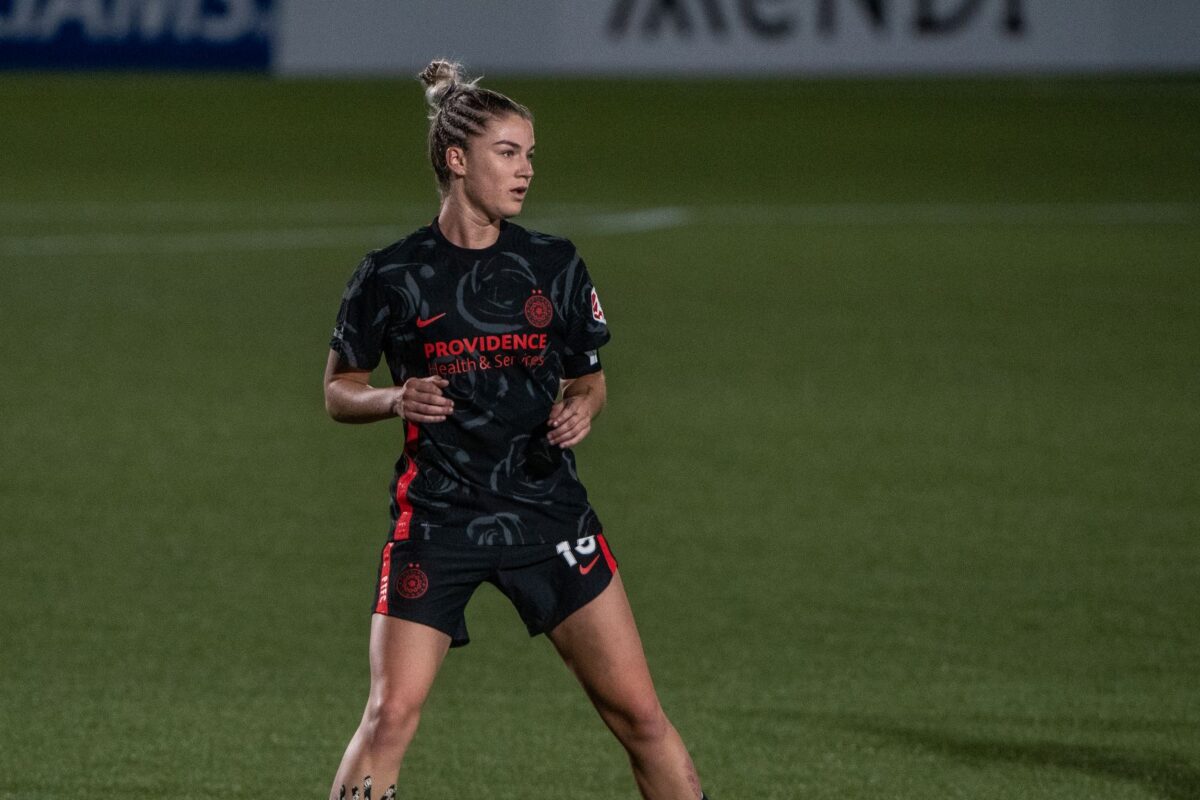
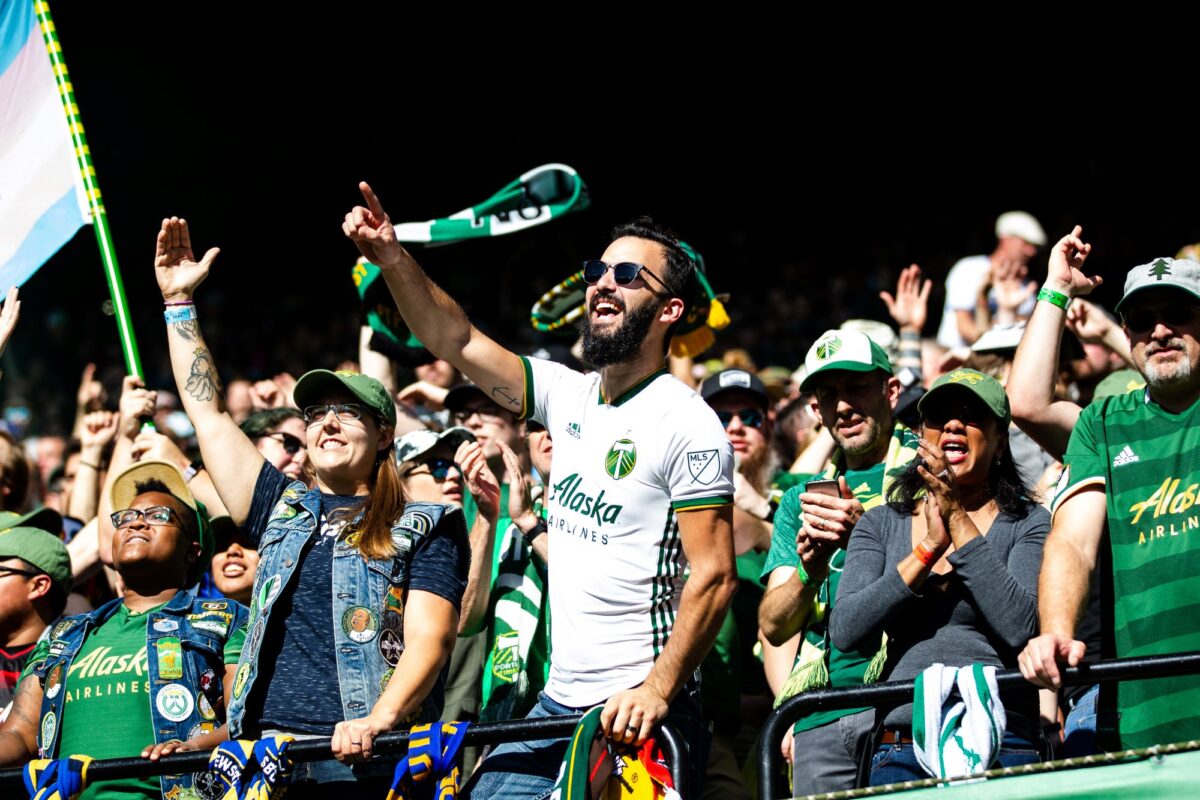
Disclosure: Jennifer Ingraham, a 107ist board member, also serves as a copy editor for Rose City Review. She was not involved in the creation of this piece in any way.
On June 1, Milo Reed published a post on Medium, detailing his experiences as a Black capo in the Timbers Army and member of the 107 Independent Supporters Trust—the nonprofit organization that coordinates both the TA and the Rose City Riveters.
Reed describes an instance from 2018, in which the 107IST Board of Directors deleted a blog post that they, a group of non-Black people, deemed to be offensive to the Black community. However, Reed, “felt that the post was not problematic & urged the 107ist board to consult communities of color before speaking for them.” He also requested the Board share a copy of his email; Reed points out that, a couple of months later, a white capo was allowed to share their own thoughts about race “on the same website [Reed] was denied access to.”
According to Reed’s post, the Board asked him to explain his requests to them at their next meeting, less than 48 hours in advance. Based on the context of the invitation, Reed believed it to be “disingenuous” and “like [the meeting] was going to be an interrogation as opposed to a conversation.”
“I can’t count the number of times I have brought a plan, concern, or proposal to a 107ist board member only to be given a metaphorical pat on the head, a terse rejection or worst of all ignored,” writes Reed. “This has only intensified in the last couple of months. I have told several people they have behaved in ways that were disrespectful & patronizing since March, only to be told ‘I’m sorry you feel that way.'”
Three days after Reed published his story, the 107IST Board shared a response, acknowledging their failure to listen to BIPOC voices in the TA and RCR—although doing so without explicitly mentioning Reed or his own blog—and declaring a commitment to publicize a detailed anti-racism plan within the next 30 days.
Reed’s post came in the wake of the murder of George Floyd, in the midst of global protests against police brutality and systemic racism and calls that Black lives matter. (“If Black Lives Matter what about Black voices?” Reed asks.)
The outcry—and wave of public statements from their Black members—has pressured many organizations to examine the role of race within the spaces they inhabit.
When examining the role of racism within these spaces, it’s important to first acknowledge that we live in a society that’s systems of power and organization were created by white people who often strove to exclude people of color. Whether through the institution of slavery, segregationist policy, or simply hostile attitudes that targeted BIPOC, they conveyed that people of color were not welcome.
Although many of these laws have been repealed, these spaces cannot be separated from their racist origins. When those in charge do not attempt to reconcile with and actively combat this racist past, those same systems of inequity remain unchecked. We see them perpetuated in the racial wage gap, in the small number of people of color—especially Black and Indigenous people, especially Black and Indigenous women—that hold leadership positions in companies, in the over-policing and mass incarceration of BIPOC, and in countless other areas of everyday life. As Simone Charley points out, these “power structures [are] so ingrained in society that to question them is to question yourself.”
Like many organizations across the United States, the TA and the 107IST are a product of the society that they belong to. Regardless of self-proclaimed anti-racism and anti-fascism, members not immune to intrinsic bias; Reed’s story shows as much. And, as tends to be the case with systemic racism, his experience is not an isolated occurrence.
“When I first moved to Portland in 2016, I didn’t know a single person there,” says Chelsea Waddell, a member of the 107IST, “definitely not anyone in the soccer community.” She recalls going to the 107IST website and reading about the group. Something stuck out to her on the 107IST’s “About Us” page: “We have always said that if you want to be Timbers Army then you already are […] Since 2013, the same has been true for the Rose City Riveters.”
“I was like, wow, what a cool sentiment,” Waddell says. “You don’t have to be anyone special or do anything to be part of this organization.
“I think you’re immediately accepted when you walk into that group,” she continues. “There’s no prior judgment of who you are because of who you are. If you’re a member of the LGBTQ+ community, which I am, and a person of color and a woman—I’m really hitting the triple threat there—you can walk in and really be embraced, but I feel like only if you agree with everybody else all the way through.”
Anabel Ramirez, who was a regular presence in the North End for roughly ten years, feels similarly about her experience in the TA. “I got hooked into it,” she says. “It felt like a cult fervor when you first join in, and you want everything: you want all the scarves, you want all the patches, you know all the chants. You get really clicked into this idea that it is a collective, and then it doesn’t feel so collective in certain aspects.”
Both Ramirez and Waddell believe that this sense of collectiveness is enforced by the unspoken expectations in the TA, and, to a lesser extent, the Riveters: standing and chanting together, cheering on the team, and staying off your phone. For those involved outside of games, it’s volunteering your time and money, helping in the creation of tifos, and contributing to 107IST fundraisers for other nonprofits around Portland.
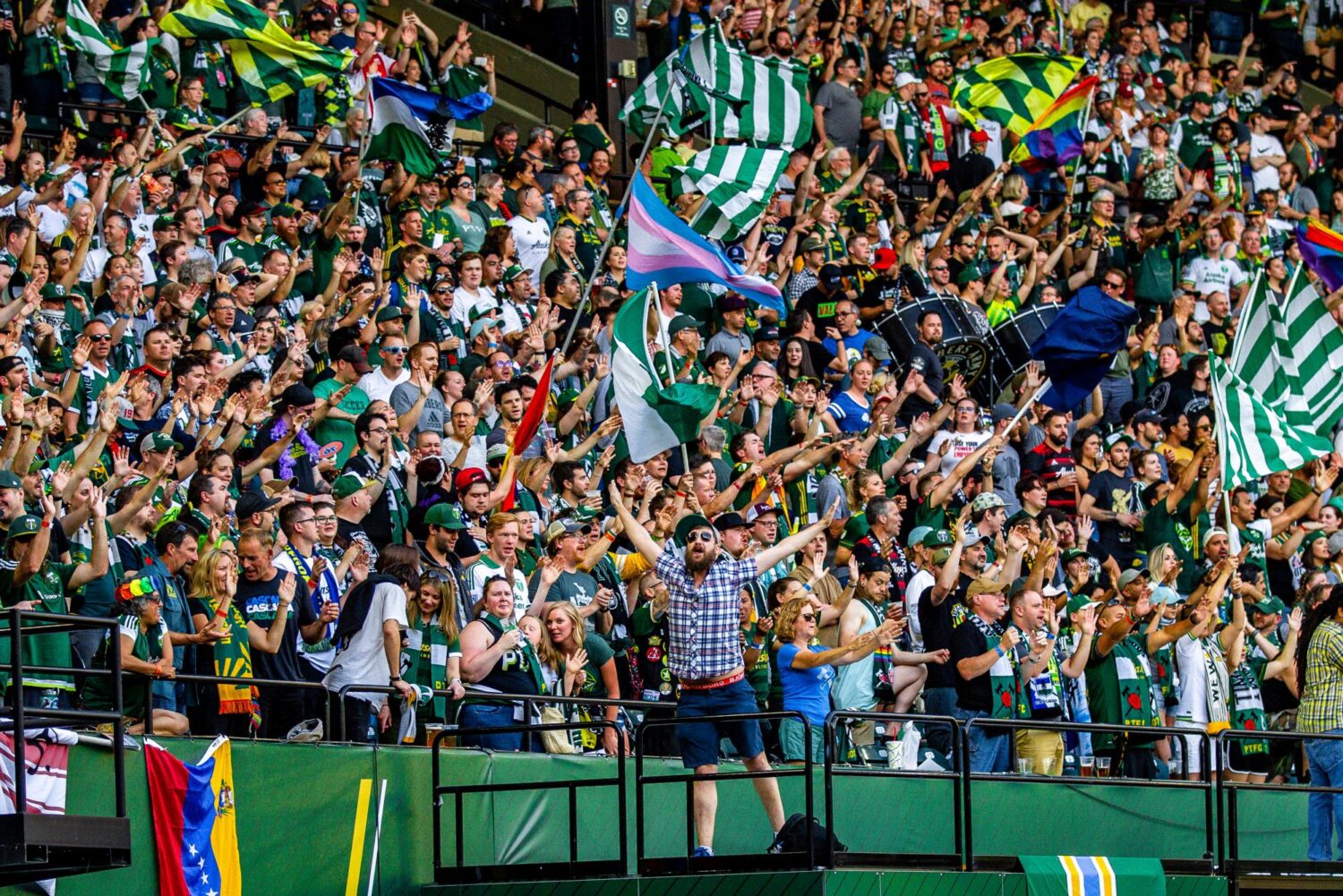
However, unspoken rules can lead those who are unaware of them, or simply wish to express their support in a different way, to feel as if they don’t belong. This is only accentuated for BIPOC fans who are already navigating a very white space.
“In trying to be this cohesive North End voice, they stamp out a lot of other voices,” Ramirez observes. “I don’t think a lot of them see themselves as stamping out specifically Black and Brown and Asian voices, but it happens.”
Ramirez points to the fact that many of her BIPOC friends don’t feel welcome in the TA—from those who simply don’t want to acknowledge the group after they displayed the Sunshine Flag, to the large numbers of Latinx families who show up at Timbers 2 matches, but not Timbers games. She, herself, felt uncomfortable in the TA unless she was with a certain group of friends.
As a Black woman, Waddell perceives the racial diversity of the TA and RCR to be similar to that of Portland, a city that is known for being very white.
To Jake Payne and Phil Bridges, this problem isn’t exclusive to Portland. The two are co-founders of Black Fires, a Black supporters group for both the Chicago Fire and the Chicago Red Stars. “You see this with a lot of supporters groups around the league,” Payne points out, “of saying that you’re inclusive and diverse, but your stands don’t really reflect that. I think that’s something that more than Section 8 or Timbers Army or anyone need to look at […] like, okay, if we’re that inclusive, why don’t our stands reflect what our values are?”
Bridges points to the fact that, in Chicago, it took over 20 years for a real push to make the stands more diverse—both in terms of LGBT and BIPOC fans—to actually happen. “You have just a lot of people who love the idea of saying that they’re diverse,” he says. “They love the idea of that, they seem open, they love talking about it, they love feeling that way, but when it comes to actually putting in the work to make sure that happens, it’s totally different.”
One of the factors is how a club markets itself. “There is the reality of soccer’s not as big as it should be in the Black community in the United States,” Payne acknowledges. On the other hand, he notes that Chicago’s clubs weren’t actively trying to engage with the Black community until Black Fires called on them to do so.
“It’s really liberating to be able to make the experience what you’ve always wanted it to be,” says Payne, “but it’s also very frustrating, because you have to constantly almost drag people to care about this in a genuine way.”
Before the COVID-19 pandemic, one of the ways Black Fires was working to reach prospective fans was through watching games with them. Payne explains that the majority of the bars that Fire supporters frequent are in the north side of the city, which is more white. “What’s a bar [where] we can watch in the south side?” he asks. “What’s a bar where we can watch that’s Black-owned or in a Black neighborhood, so that we can be more present?”
Payne thinks this engagement is an important step beyond a trap that many fall into—fans or otherwise. Too often, he points out, “donating takes the place of actually reaching out to communities that need it and making a connection.”
Both Ramirez and Waddell notice this within the TA and RCR. “I don’t feel like they are actively fighting for people of color,” Waddell says. “I think they are passively allowing them to be a part of it, and openly embracing different people, but never going any deeper than that.”
As an example, she and Ramirez point to the 107IST’s donation drives for other nonprofits in Portland.
“I do think that the organization can be a little bit show-y, white savior-y, performative,” acknowledges Waddell. “In football culture, being antifascist and fighting for marginalized people is really, really cool, but I feel like we do it just because it’s cool […] There’s just not a lot of substance there.
“It doesn’t really matter if you can fly a certain flag or wear or display a certain symbol if you’re not doing other things to support that fight. It’s just a symbol.”
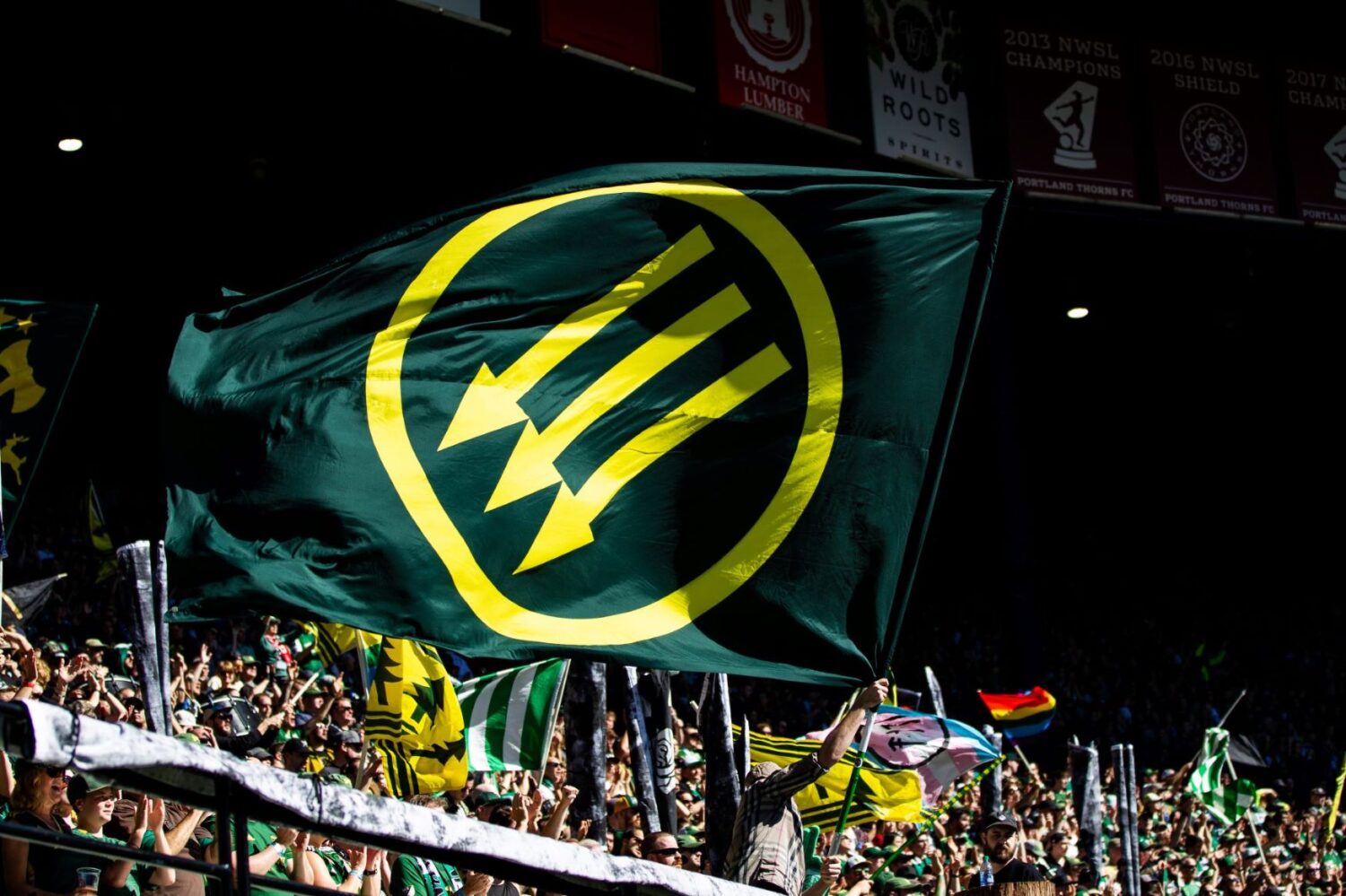
In her time with the 107IST Outreach Committee, Ramirez notes that the group would donate to organizations without making any effort to engage with the communities that those organizations represented. She explains that this was one of the main reasons she ended up leaving the committee. At the time, Ramirez said as much to the 107IST, but didn’t feel like anyone was paying attention.
“I feel like every time I would go and try to make a suggestion of some sort—it was either because I was female or because I was Latina or probably the combo—that I wasn’t getting listened to,” she says.
For Waddell, this failure to listen to BIPOC voices became evident during the discourse around the Iron Front last summer. “Obviously, this was a really passion-driven discussion, but from where I sit, part of that fight was to ‘protect’ me,” she says. “I feel like there was no space given to the people that people were fighting for.
“I just, as a person of color, didn’t see how displaying a symbol would change anything for me,” Waddell explains. “I think that’s kind of the discussion we’re at this summer, on a bigger scale, is that it’s not displaying a symbol that makes people feel safer; it’s action and words and listening to them.” While she wanted to express this at the time, she was afraid of the backlash she would face for presenting an opinion that differed from the group’s.
That fear of retaliation was validated by Reed’s post, by his stories of trying to speak up and the resistance he faced. “It was brave of him to even try,” Waddell says, “and still no one listened.”
When Reed was offered an opportunity to communicate with the 107IST Board, it was on short notice and in a space of the Board’s own creation. “[It’s] like, ‘yeah, we will listen to you,'” describes Payne, “‘but only in these predefined structures that we feel work, this is how we’ll listen to you.'”
Payne acknowledges that a refusal to listen to BIPOC voices unless they’re speaking in white-created spaces is a systemic issue: “I think that’s how a lot of places operate, not just in soccer, and it’s just not right.”
To Payne, now is a perfect time to examine the ways in which any organization perpetuates systemic racial inequity—intentionally or not. “[The] Timbers Army is just in the spotlight because they had the most public thing about it,” he says. “Plenty of other groups operate like this right now, and I think this is a good time—with it being a ‘break in society,’ with not many supporter initiatives happening—for any group, NWSL, MLS, USL, to really be thinking about, ‘okay, how are we operating?’ Especially the older groups, like Timbers Army or like Section 8: ‘this is how we’ve been operating, but is it the right way to operate?’ I think that really needs to be a big question going forward.”
“We are […] evaluating the different committees within the organization, looking to create more transparency and points of entry,” says Gabby Rosas, the newly-appointed president of the 107IST Board.
In the follow-up report from the 107IST, she shared the Board’s plan to reevaluate different areas of their operations. These include a BIPOC committee, a list of the specific places the Board is hoping to address, a summary of the outside groups the Board has formed partnerships with, and a handful of suggested books, podcasts, and movies.
“Personally, I have been reflecting on my own pathways into the organization, my own decision to run for the board, and advantages I’ve had as a white-passing person in Portland,” says Rosas, when asked about the work she’s done to examine the role of whiteness in the 107IST. “This is a large organization with many people who care passionately about the Timbers, the Thorns, supporter culture, and the community. It can be very intimidating, and I have not done a good job of recruiting and sustaining their participation, I should have been more extroverted when it comes to getting others involved in all aspects of what this organization does.”
She points to the barriers of entry that exist within the organization focusing on the time commitment asked of those involved. “There are many barriers to entry and advancement, from the supporter group involvement to the board election,” she explains. “I have been and will continue to identify barriers and address them.”
For Waddell, the hours asked of the BIPOC team was a major reason she didn’t join when invited. “I don’t really have time to volunteer to teach this Board how to just listen to people of color,” she says. “And I think there’s a lot more going on within the organization that they need to do to support people of color, but […] there’s no class you need to take or book you need to read or podcast you need to listen to to understand how to just listen to someone when they speak.”
The other factor was money. The BIPOC committee, like other 107IST committees and Board positions, is run by volunteer work. However, Waddell currently does diversity, equity, and inclusion work for her job, and felt it wasn’t worth taking on additional emotional labor—especially, for free.

The BIPOC team shares that they now have 20 members on board, 10 of whom are currently actively involved. According to the 107IST update post, the committee has met twice so far. They “plan on meeting again soon while we work on our mission statement and other tasks that include the board.”
When asked about how the member-led BIPOC committee will remain impartial in their evaluation of the 107IST, Rosas says: “Everyone’s experience with this organization is valuable, be it positive or negative, or if they are a member or non-member. We are also not opposed to working with other local groups for guidance and insight as this committee is formed.”
The committee is not following a specified timeline, but Rosas explains that the Board isn’t planning to sit around and wait. “The hope is that as we work to remove barriers for entry and highlight different pathways in our organization, we can do so in such a way that will address the needs of marginalized groups,” she says. “As we work on change, we will be doing so at a pace where we can check in with our community, including the BIPOC team, and local organizations that have offered their support. Our goal is to be able to incorporate the feedback and tasks from the BIPOC team as they want to provide it.”
One of the ways Rosas hopes to do this is by increasing the accessibility of Board meetings. “We have never had the attendance at another board meeting like we did the June meeting,” she shares, a meeting that happened virtually to accommodate for the COVID-19 pandemic. In response, the 107IST is moving their monthly meetings to online, accessible spaces. Rosas points specifically to Google Meet, which offers closed-captioning.
As another area of focus, she hopes to more actively work with local organizations that serve BIPOC communities and other marginalized groups. “If we can increase our engagement, both through volunteering and by inviting them to 107ist events, we will hopefully be able to improve the accessibility to joining the Rose City Riveters, Timbers Army, and 107ist,” she says.
To open up space for BIPOC voices, former 107IST Board member Ray Terrill stepped down from his position and asked that his spot to be filled by a person of color. Sherrilynn “Sheba” Rawson also resigned her presidency to Rosas, although Rawson remains on the Board.
For Ramirez, those changes aren’t good enough. “Until there are at least three seats on the board filled by BIPOC, I don’t think they can move forward on this,” she says.
Rosas believes that we’ll see that shift later in the year. She explains that, as advised by Western States Center’s Eric Ward, many members have chosen “to not resign but to work on the changes until BIPOC appointments can be made or elected.”
Come Board elections in November and December, Rosas thinks the leadership changes will materialize. “I imagine that a number of board members will either choose to not re-run or step down at that time,” she says. “We will actively work with the BIPOC team should individuals want to join the board. We not only want BIPOC members on the board but also on all of the committees throughout the organization.”
Key to this will be accountability; the 107IST will have to prove that they’re seeking out and paying attention to BIPOC voices going forward. “I think a major way to prove the 107ist board is actually listening is to make changes based on what is heard and then to keep checking in to see if the changes have had an impact,” says Rosas. “I expect that many aspects of the change that is needed will not be one and done.”
Whether or not those changes play out in meaningful ways remains to be seen. However, BIPOC fans speaking up now hope that, this time, listening to their stories is a first step.
“I really love this organization,” says Waddell. “I love the team, every single player, everybody who’s at the games, everybody who’s watching from home. It means a lot to me, and that’s why I do want to speak about it. It’s not out of hate, it’s out of we can do better, and we need to do better, and we have the passion to be better […] I really do love this organization and these groups, and everything I’m saying is out of the understanding that we can be better. We have to.”
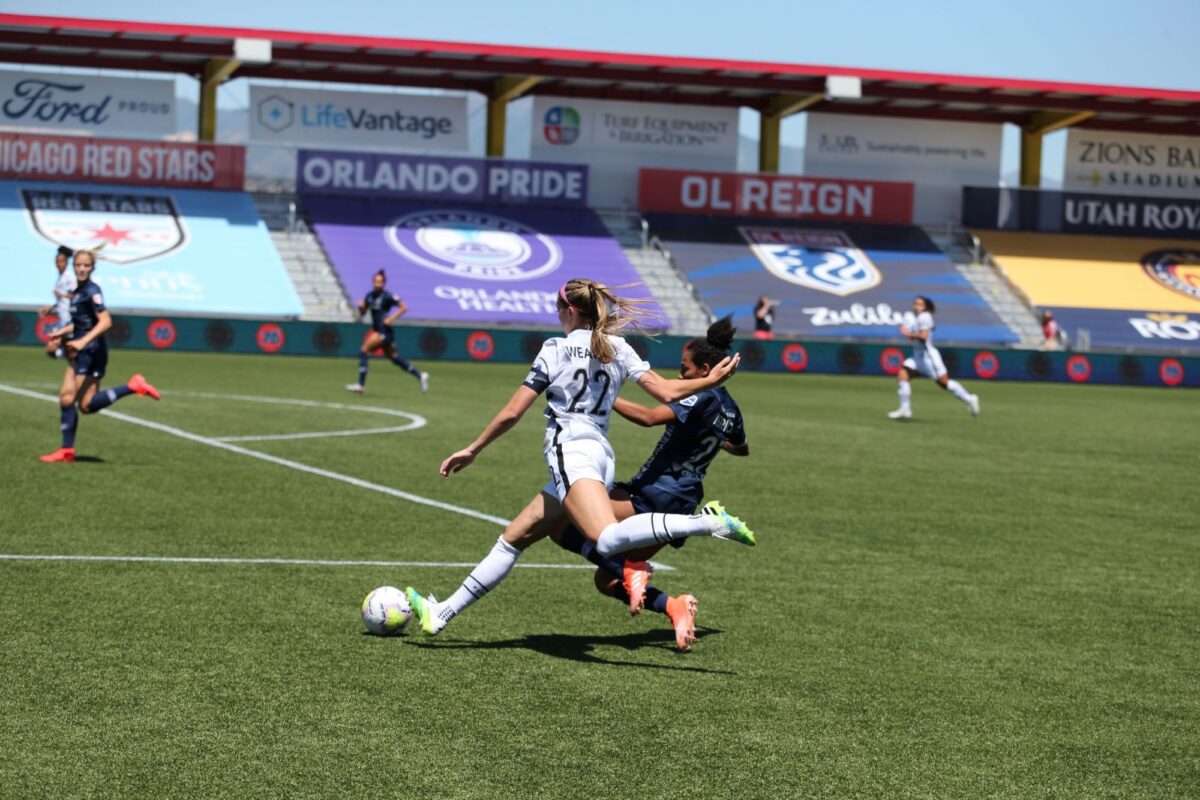
In its second game in the 2020 NWSL Challenge Cup, the Portland Thorns played the Chicago Red Stars to a 0-0 draw.
With both teams playing last Saturday, lineup rotation was no surprise. Only four of the players who started for the Thorns against North Carolina did so again today, while Chicago showcased a completely different starting XI.
We saw it in yesterday’s 3-3 draw between the Utah Royals and Houston Dash: chaos is fun. Today’s match was less back-and-forth on the scoreboard—and, admittedly, a little less fun because of it—but scrappy play and all-out attacking soccer set a somewhat similar tone throughout the game.
From a very physical midfield battle with few fouls actually called to Autumn Smithers making her NWSL debut at centerback to Morgan Weaver running full-steam at Chicago’s backline, this morning’s match stood in stark contrast with last night’s build-out-of-the-back game between Sky Blue FC and OL Reign.
The Thorns got a decent number of looks on goal in the opening 20 minutes of the match, especially finding success through Weaver and Simone Charley’s wide runs. Both of Portland’s forwards found a handful of crosses in the first half, trying to find the central run of Lindsey Horan or try their own luck on frame.
Weaver had success putting Chicago’s defense under pressure with her speed, cutting inside, and beating the Red Stars backline to get on the end of through-balls, while Charley was tasked with dropping back more and beating players on the dribble.
Unfortunately, too many of Portland’s chances were directed high or straight at Chicago’s keepers, never really testing Emily Boyd or Cassie Miller.
Making runs out of midfield, Celeste Boureille looked sharper than she has in a while, threading balls ahead to Weaver and earning her own looks on goal. If she had been slightly quicker in taking those shots, that’s yet another potential scoring opportunity for Portland.
Earning her first start for the Thorns alongside Smithers—a player making her professional debut—and in front of a goalkeeper playing in her second ever NWSL game, Christen Westphal had a lot of defensive responsibility in this match. With two of Portland’s veteran defenders, Becky Sauerbrunn and Katherine Reynolds, sitting out the game with injuries, this game became Westphal’s chance to prove herself as a reliable depth piece.
And, for the most part, she did just that: anchoring the Thorns defensive line, finding a handful of blocks against a similarly-untested Chicago attack, and carrying that performance outside when Emily Menges came in at halftime.
However, as a team that likes to push high with wingbacks, or play out of the center with the distribution of Reynolds (or now-departed Emily Sonnett or Elizabeth Ball), Westphal’s performance left gaps to be desired. Often, she’d get on the end of balls and simply play it out rather than working her way up the field, or she’d push high to win a ball but miss the header.
Granted, Chicago wasn’t giving Portland all that much time with the ball at their feet, and granted, she’s coming off two injury-ridden seasons, but that’s something Parsons will want to see more of as Westphal earns more time in the future.
It shouldn’t really come as a surprise that Horan was everywhere in her time on the field. Whether she was making the run to be Portland’s target in the box or dropping back to help out Madison Pogarch or combining with Celeste Boureille in midfield, her presence was clearly felt across the pitch. And yeah, the Thorns didn’t get as much out of her as they would have liked last year, but otherwise that’s been her role throughout her time with the club.
However, we all saw how battered her shin looked after coming off for Raquel Rodríguez in the 69th minute, and at some point or other in this tournament, the Thorns are going to have to play significant time without her and without Christine Sinclair in the No. 10. Rodríguez can fill one of those roles, but not both—she may be good, but she’s only one person. Boureille showed promise stepping in at the No. 8 today, but she’s still a clear step below The Great Horan. With only three days off between this game and the next, we’ll see what Parsons pulls together.

With the NWSL set to become the first American sports league to attempt a restart, the eight teams—minus the Orlando Pride, who, as we learned Monday, will sit out due to multiple positive COVID-19 tests on the team—that will participate in the Challenge Cup released their rosters yesterday.
One thing is certain: between a huge amount of offseason tumult and a stack of last-minute contracts—not to mention yesterday’s announcement that Tobin Heath will not participate—this won’t be a Thorns team we’ve ever seen before. A few of our thoughts on the newly announced roster are below.
The Thorns, presumably, had a plan heading into this season. Amid whispers of a needed culture change, the club sent half the roster packing, snagged two promising young forwards at the draft, and made moves for Becky Sauerbrunn and Rocky Rodríguez. Fill in a few more blanks, and it’s easy to envision a good soccer team materializing—but those blanks never got filled. What we’re left with is pieces to a whole that never got finished.
Things were cast into even more doubt last week with the departure of Ellie Carpenter. With her departure, Sauerbrunn—a legendary but aging, and slowing, center back—starts to look less adequate as the season’s big defensive acquisition. The team has options at right back, but it’s hard to envision any of them filling Carpenter’s shoes on day one against North Carolina.
But here’s the good news: soccer is a game. More good news: this “season” isn’t real. Even more good news: historically, the Thorns have played some of their most fun, memorable games without their veterans. This isn’t the same as a World Cup or an Olympics—Lindsey Horan and Christine Sinclair will be there—but the tight schedule means we’re sure to see more squad rotation than we normally would. The sheer volume of new names on this roster means it’s impossible to guess which players are going to be the Meg Morrises or Simone Charleys of this tournament.
That’s not to mention the proven names new to this Thorns roster; Rodríguez obviously falls into that category, as does, I would argue, Sophia Smith. This group of forwards, in particular, is mostly quite young, and none of them are French, but I’d bet they’re going to be a hell of a lot of fun to watch. Wacky stuff is going to happen in this tournament. Let’s enjoy it, yeah?
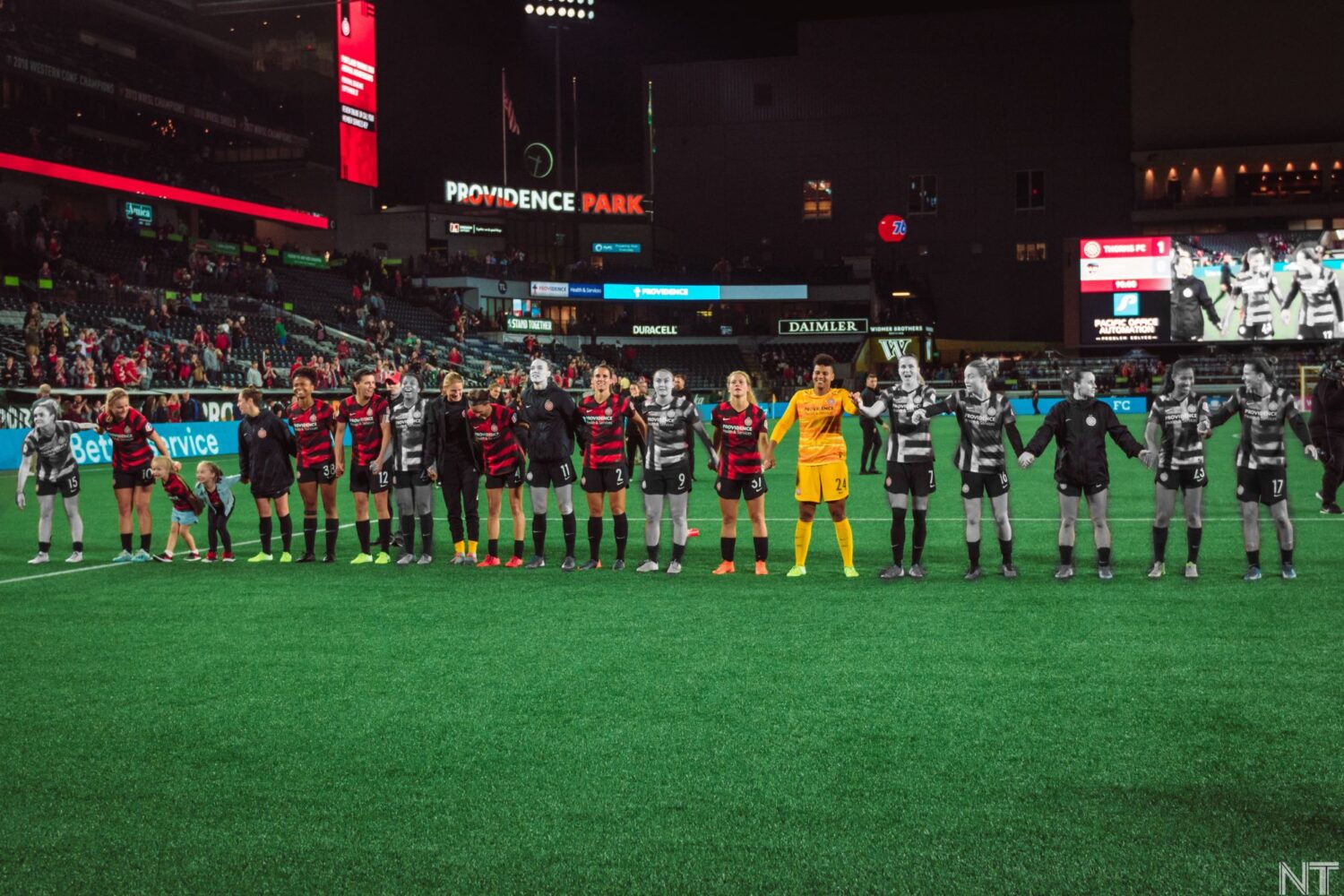
I have this theory that’s going to sound ridiculous when I say it, but bear with me: Horan is a problem. More specifically, the role Horan plays for the Thorns is a problem.
In 2016 and 2017, Portland deployed Horan and Amandine Henry in the central midfield as dual No. 8s. Both could play disruptor, both could set plays in motion, and both could make forward runs and score themselves. They would trade off on these duties, one sitting back while the other pushed into the attack, and this worked because Henry is just as good at all those things as Horan.
When Henry left, Mark Parsons wanted to continue using the same system, swapping Andressinha in alongside Horan. This went… less well. Andressinha simply isn’t a strong or physical enough player to fill that role. Since then, a succession of players have been tapped to fill that third midfield slot, including Celeste Boureille, Dagný Brynjarsdóttir, and Gabby Seiler. Boureille, for a moment in 2018, worked well; she doesn’t have Henry or Horan’s creative brilliance, but she proved to be a good disruptor deep in midfield. Seiler, for a still briefer moment in 2019, looked even more promising. But none of them have played as Horan’s double like Henry did—unsurprising, seeing as none of them are in the conversation for being the best central midfielder in the world.
This is the question: is there another player anywhere on earth capable of playing a second No. 8 alongside Horan as effectively as Henry did?
Parsons intends to try again with Rodríguez. On its face at least, this makes a lot more sense than trying to convert Andressinha into a No. 8 did, seeing as Rodríguez has played a box-to-box role in the NWSL, you know, ever, although never in the same system; at Sky Blue, she played alongside Sarah Killion, a much more defensive player than Horan. The question is how well Rodríguez can partner with a player who, at any moment, can show up anywhere on the field.
I’d describe myself as curious, leaning toward optimistic about this. At any rate, I’m excited to see Rodríguez, who I think has been underperforming for a few years, in a new environment. And if it doesn’t turn out? Try her at right back, why not!
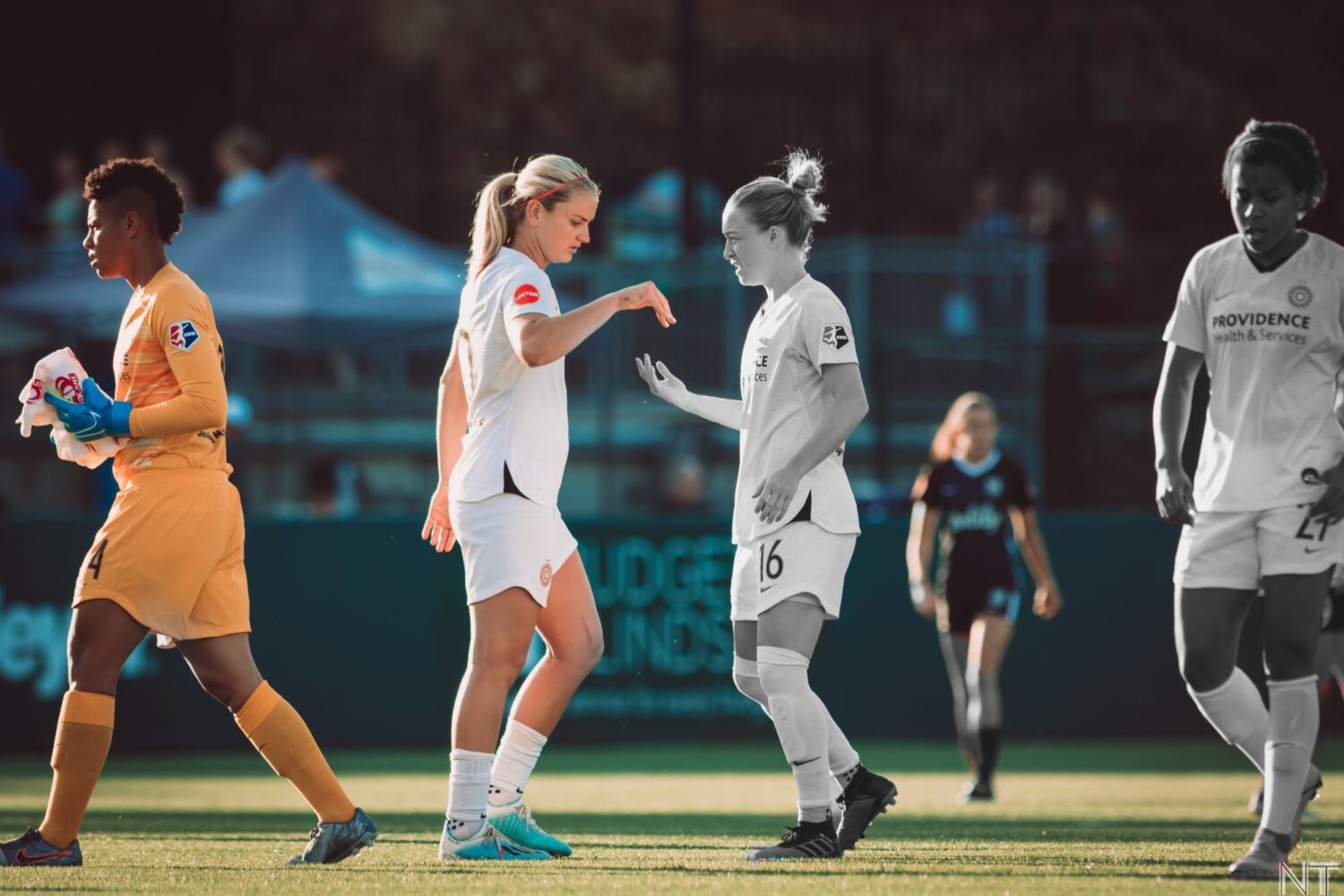
With all of nine players listed as defenders on this roster, one presumably would not have as many questions about Portland’s back line as I do. With a schedule that has the Thorns playing their opening three games over the course of nine days, rotation is going to happen, and I think it’s going to happen sooner than we expect.
If you look at a back four of Meghan Klingenberg, Emily Menges, Sauerbrunn, and Katherine Reynolds, something comes to the forefront pretty quickly: three of them are over 30 and two of them aren’t particularly fast. (Menges, of course, is the exception in both these statements, and Sauerbrunn isn’t slow, per se, but as Katelyn points out above, she’s definitely past her peak.) And while they’re all very capable players, the quartet leaves something to be desired against a fast, high-pressing North Carolina.
On the other hand, Parsons isn’t exactly known for throwing young players into the line of fire. But if these games don’t really matter, there’s no time like the present to experiment, right? Yeah, there’s still Kelli Hubly and Christen Westphal—and where is Seiler going to play? As the No. 6 in a diamond midfield? Somewhere in defense?—but I personally think it would be very cool if Madison Pogarch got the start on Saturday. And why not give Meaghan Nally and Autumn Smithers some time in this tournament while we’re at it?
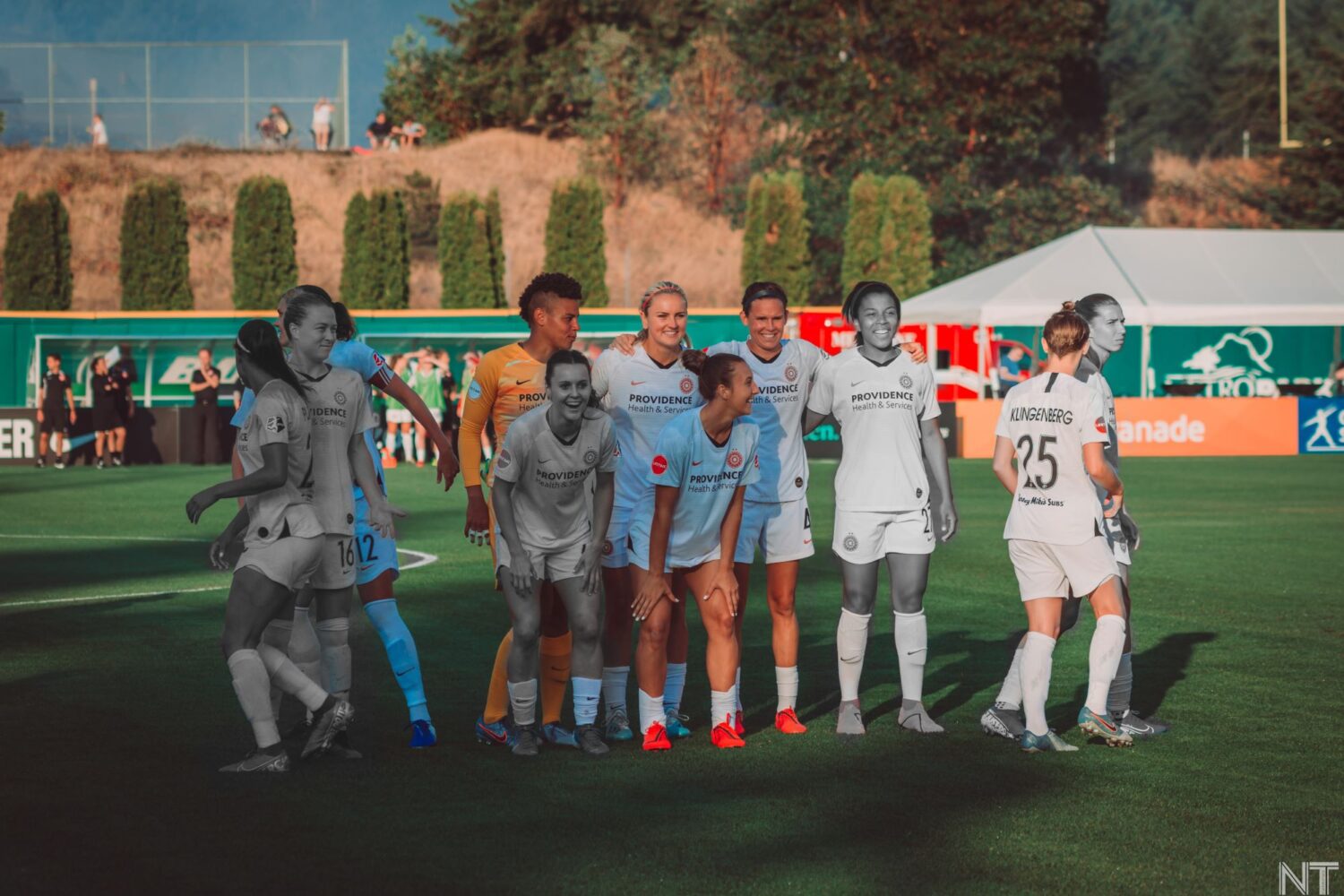
Guess what I remembered today? Two-time NWSL Goalkeeper of the Year Adrianna Franch still plays for the Thorns. Not only that, but she won’t be missing games that she could be playing with the Thorns for national team duty.
Given the experimentation we’re going to see with this team, having arguably the best keeper in the league—and undisputedly the one with the best handling—means, worst comes to worst, at least we’ll see some great goalkeeping.
Tobin Heath has chosen to stay at home for this tournament. That is her right as a player, and it’s one that all the players in the NWSL have, as guaranteed by the negotiations between the player’s association and the league. Looking at the state of coronavirus cases in the US and Utah specifically, it’s a perfectly reasonable decision to make, and knowing how much she lives for soccer, it has to be an incredibly painful one.
What it means for the team is that, with the departures of Midge Purce, Hayley Raso, and Caitlin Foord in the offseason, no regular-rotation players from the 2019 forward line will play in the NWSL Challenge Cup. Sure, Christine Sinclair is listed as a forward, but you and I both know that’s not how it works, and in a compressed schedule, it’s even less how it works. Sinclair is simply not going to be running around full tilt for 90 minutes on three day’s rest, as much as I’m sure she wants to.
No, the forward line is going to a rotation of players who, while extremely talented, haven’t proven themselves as starters in the NWSL yet. This is going to be an attacking bullpen with no hierarchy and no secure starting places. Expectations are high for some of the talent on hand, but there’s quite a bit of depth, so the team can afford to take some risks if things need to be shifted around.
Heath has such gravity in the team and is so important that when she’s in the team they will almost always play in a very specific way, with Heath one of the three up front drifting inside. No one plays exactly how she does, so without her, Parsons has experimented with back threes, relying on wingbacks for depth. But with Carpenter’s departure, the team has only one proven attacking option from deep in Klingenberg.
So where is the attack going to come from? Sophia Smith and Morgan Weaver, the Thorns’ first-round draft picks, were both wide players who specialized in cutting inside and shooting in college. The Thorns could, in theory, play only them up top and load up another player in midfield to get more creation there. That would mean leaving Simone Charley and Tyler Lussi out of lineups though, and both are high-energy players whose styles of play, in totally different ways, can completely throw defenses off guard. Charley’s ability with the ball at her feet on the break, and Lussi’s combination of strength and shooting mastery will both likely prove useful up against different defenses. Marissa Everett showed off a knack for poaching shots in her limited minutes last year, impressing the team enough to earn a contract this year, and Anika Rodriguez, yet another undrafted player the Thorns picked up this offseason, flashed some creative passing playing alongside Ashley Sanchez at UCLA. The depth probably doesn’t even end there. Parsons loves throwing young defenders into the fray as attackers: this is where Pogarch got her first minutes for the club, so the new defenders could absolutely see some minutes there. The possibilities seem endless. It’s now on these young players to make the most of their opportunities.
Goalkeepers (3): Bella Bixby, Britt Eckerstrom, Adrianna Franch (FED-USA)
Defenders (9): Kelli Hubly, Meghan Klingenberg, Emily Menges, Meaghan Nally (CDP), Madison Pogarch, Katherine Reynolds, Becky Sauerbrunn (FED-USA), Autumn Smithers, Christen Westphal
Midfielders (6): Celeste Boureille, Lindsey Horan (FED-USA), Emily Ogle, Rocky Rodríguez (INTL), Angela Salem, Gabby Seiler
Forwards (7): Simone Charley, Marissa Everett, Tyler Lussi, Anika Rodriguez, Christine Sinclair (FED-CAN), Sophia Smith (CDP), Morgan Weaver (CDP)
Key: CDP—2020 NWSL College Draft pick; FED—Federation Player; INTL—International Player
